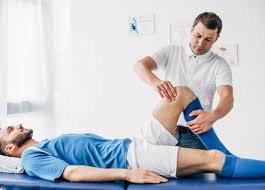In the world of athletics, where every second counts and every movement can make or break a performance, finding that extra edge is essential. Enter sports massage – a powerful yet often underappreciated tool in an athlete’s arsenal. Imagine gliding into your next competition feeling not just ready, but rejuvenated; muscles primed and tension released. This isn’t just wishful thinking—sports massage has been proven to enhance performance, accelerate recovery, and reduce injury risk. Join us as we delve into the transformative benefits of this therapeutic practice, unlocking new levels of endurance and strength that will take your game to unprecedented heights! Whether you’re a weekend warrior or a seasoned pro, discover how incorporating sports massage massage into your routine can be the secret ingredient you’ve been searching for!
Introduction to Sports Massage
Athletes are always on the hunt for that extra edge. Whether it’s pushing through rigorous training sessions or recovering from intense competitions, they need every advantage available. Enter sports massage—a powerful tool often overlooked in the athlete’s toolkit. This therapeutic approach goes beyond mere relaxation; it plays a crucial role in enhancing performance and speeding up recovery times.
Imagine easing muscle tension after an exhausting workout or preventing injuries before they even start. Sports massage offers these benefits and more, helping athletes feel their best when it matters most. Curious about how this practice can transform your athletic journey? Let’s dive into the world of sports massage and discover its remarkable advantages!
How Does Sports Massage Benefit Athletes?
Sports massage offers a range of benefits tailored specifically for athletes. It enhances circulation, which helps deliver oxygen and nutrients to tired muscles. This improved blood flow can lead to quicker recovery after intense workouts.
Additionally, sports massage aids in reducing muscle tension. By relieving tightness and knots, athletes often experience increased flexibility and a greater range of motion. This is crucial for performance optimization.
Pain relief is another significant advantage. Whether it’s soreness from training or lingering discomfort from past injuries, targeted techniques can alleviate these issues effectively.
Moreover, regular sessions help prevent injuries by identifying potential problem areas before they become serious concerns. Athletes who incorporate sports massage into their routine may find themselves competing at their best more consistently.
Types of Sports Massage Techniques
- Sports massage encompasses various techniques, each tailored to meet specific athletic needs.
- One popular method is Swedish massage. It employs long, flowing strokes that promote relaxation and enhance circulation. This technique is excellent for overall recovery after intense workouts.
- Deep tissue massage targets the deeper layers of muscle and fascia. It’s particularly effective for athletes dealing with chronic pain or tension from repetitive movements.
- Trigger point therapy focuses on tight knots in muscles, providing relief by applying pressure to these sensitive spots. This can improve flexibility and reduce discomfort during activities.
- Another technique is myofascial release, which addresses restrictions in the connective tissues surrounding muscles. This gentle approach can help restore movement and alleviate pain.
- Lastly, sports-specific massages are customized based on an athlete’s particular sport or activity demands, ensuring targeted treatment that enhances performance while preventing injuries. Each technique plays a crucial role in optimizing an athlete’s physical condition.
When Should Athletes Get a Sports Massage?
Timing is everything when it comes to sports massage. Athletes can benefit from this therapy at various stages of their training cycle.
Before an event, a session can help prepare muscles. It warms them up and increases circulation. This primes the body for peak performance. After intense workouts or competitions, massage aids in recovery. It reduces soreness and helps flush out toxins built up during exertion.
Regular sessions throughout the week maintain muscle flexibility and range of motion. They also support injury prevention by addressing tight areas before they become problematic. Listening to your body is key. If you feel tension or pain, schedule a massage sooner rather than later. Consistency tailored to your training routine enhances overall well-being and keeps you performing at your best.
Common Injuries Treated with Sports Massage
Sports massage is particularly effective for addressing various common injuries that athletes face. Muscle strains are frequent, especially in high-intensity sports. The focused pressure of a massage helps alleviate tension and promotes quicker recovery.
Tendonitis, another prevalent issue among athletes, can benefit from targeted techniques that reduce inflammation. By loosening tight muscles around the affected area, sports massage encourages better blood flow and healing. Sprains also respond well to these therapeutic sessions. Massaging the surrounding tissues aids in reducing stiffness while enhancing mobility.
Additionally, chronic conditions like plantar fasciitis find relief through specialized techniques aimed at easing foot pain and discomfort. This not only enhances performance but also improves overall functionality.
The combination of relaxation and rehabilitation makes sports massage an invaluable tool for injury management within athletic training regimens. Athletes often find they recover faster and return to their sport with renewed vigor after such treatments.
Tips for Choosing a Qualified Sports Massage Therapist
Finding the right sports massage therapist can be a game changer. Start by seeking recommendations from fellow athletes or coaches. Personal experiences often lead you to skilled professionals.
Check for certifications and credentials. A qualified therapist should have specialized training in sports massage techniques, ensuring they understand your specific needs.
Don’t hesitate to ask about their experience with your sport. Different activities may require tailored approaches, so finding someone familiar with the demands of your discipline is beneficial. Consider scheduling an initial consultation. This meeting allows you to discuss any concerns and gauge their communication style. Comfort and trust are essential for effective treatment.
Finally, ensure that the therapy environment feels welcoming and professional. A clean space contributes significantly to relaxation, enhancing your overall experience during each session.
Incorporating Sports Massage into Your Training Routine
Integrating sports massage into your training routine can significantly enhance performance and recovery. It’s not just a luxury; it’s an essential component of athletic care.
Scheduling sessions around your training cycles is crucial. For instance, a massage after intense workouts helps alleviate muscle soreness and prevent injury. Consider a pre-competition massage to stimulate blood flow and prepare your body for peak performance. This technique primes muscles, making them more responsive during events.
Listening to your body is key. If you feel tightness or fatigue, that’s the perfect time for some focused therapy. Regular sessions create a rhythm in recovery, allowing athletes to train harder without burning out.
Lastly, communicate with your therapist about specific areas of concern or tension. Tailoring each session ensures that it aligns perfectly with your individual needs and goals in sport.



